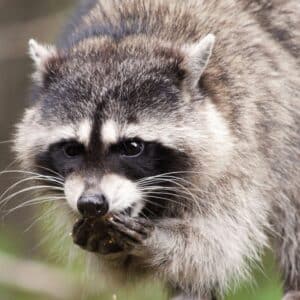
RACCOONS
FUN FACT
Raccoons have incredible dexterity and can open complex locks. Additionally, they maintain an average of seven den sites, complete with food stores, ready to relocate at any time.
Schedule Your Raccoon RemovalCall (512) 764-5804Identification
Raccoons, known for their distinctive black “masks” and dexterous front paws, are widespread across the United States. These adaptable creatures thrive in both rural and urban environments. They are omnivorous, eating everything from insects and berries to small mammals and garbage, often seeking human-provided food sources.
Signs of Infestation
- Trash Issues: Overturned or ripped garbage cans.
- Property Damage: Damage to attics, chimneys, and siding as raccoons search for entry points.
- Footprints: Small, five-toed prints in muddy areas or soft soil.
- Daytime Activity: Although primarily nocturnal, raccoons may be seen during the day if food is scarce.
- Dens: Nests in trees, attics, or under sheds.
- Excrement: Concentrated areas of raccoon droppings.
Breeding Season
Raccoon breeding occurs from late winter to early spring. After a 63-day gestation period, 3-7 kits are born in early summer. The kits are blind and helpless at birth, relying on their mother for care. Raccoon mothers are protective and may move their young to different den sites if they sense danger.
Ecosystem Role
Raccoons help control insect populations and disperse seeds, contributing to ecosystem balance. They also serve as prey for larger predators, playing a crucial role in the food chain.
Prevention Strategies
- Secure Your Trash: Use heavy-duty trash cans with tight-fitting lids or store garbage securely.
- Eliminate Food Sources: Remove pet food, birdseed, and fallen fruit from your yard.
- Seal Entry Points: Inspect and seal gaps or holes in your home.
- Use Repellents: Follow instructions for commercial raccoon repellents.
- Habitat Modification: Trim tree branches away from your roof and remove potential den sites.
- Scare Tactics: Employ motion-activated sprinklers or loud noises to deter raccoons.
Prickly Pear’s Approach
- Inspection: Identify signs of raccoon activity and potential entry points.
- Exclusion: Implement barriers and seal entry points to prevent raccoon access.
- Humane Removal: Safely and humanely remove raccoons from your property.
- Follow-Up: Regularly monitor and adjust strategies to keep raccoons away.
Conclusion
Raccoons, while fascinating and fun to watch, can sometimes cause chaos. Prickly Pear offers professional services to manage raccoon activity and protect your property. If you suspect a raccoon problem, contact us for expert assistance.
Habitat and Behavior Bats are most active at night, emerging at twilight to hunt for insects. They thrive in warm climates, with large populations found in southern states. Bats roost in places that offer shelter and warmth, such as attics, chimneys, caves, and even under bridges. During the breeding season in late spring and summer, female bats form maternity colonies to give birth and raise their young.
Prickly Pear’s Approach
- Exclusion: We inspect your home for potential entry points and seal them using caulk or wire mesh to ensure bats cannot enter.
- Habitat Modification: To make your home less inviting to bats, we remove potential roosting spots and install one-way exclusion doors that allow bats to leave but prevent them from returning.
- Humane Solutions: If bats are already roosting in your home, we employ humane exclusion methods, ensuring they are evicted safely and without harm, especially when they are not raising young.
Conclusion Bats play a vital role in balancing ecosystems by controlling insect populations and aiding in pollination and seed dispersal. However, having them roost in your home can be a nuisance. Prickly Pear Wildlife offers professional, humane bat exclusion services to keep your home bat-free while respecting these incredible creatures. If you suspect a bat infestation, contact us for expert assistance in securing your home.
